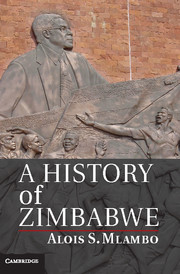Book contents
- Frontmatter
- Dedication
- Contents
- Figures
- Tables
- Maps
- Acknowledgements
- Timeline
- Notable Figures in Zimbabwean History
- 1 Introduction: Zimbabwe in Historical Perspective
- 2 Early States, c. 900–1900
- 3 The British Conquest State
- 4 Colonial Economy and Society to 1953
- 5 The Federation Years, 1953–1963
- 6 Nationalist Movements to 1965
- 7 Unilateral Declaration of Independence and African Response
- 8 Independent Zimbabwe, 1980–2000
- 9 The Crisis Years, 2000–2008
- 10 Conclusion: Zimbabwe Past, Present and Future Prospects
- Select Bibliography
- Index
1 - Introduction: Zimbabwe in Historical Perspective
Published online by Cambridge University Press: 05 June 2014
- Frontmatter
- Dedication
- Contents
- Figures
- Tables
- Maps
- Acknowledgements
- Timeline
- Notable Figures in Zimbabwean History
- 1 Introduction: Zimbabwe in Historical Perspective
- 2 Early States, c. 900–1900
- 3 The British Conquest State
- 4 Colonial Economy and Society to 1953
- 5 The Federation Years, 1953–1963
- 6 Nationalist Movements to 1965
- 7 Unilateral Declaration of Independence and African Response
- 8 Independent Zimbabwe, 1980–2000
- 9 The Crisis Years, 2000–2008
- 10 Conclusion: Zimbabwe Past, Present and Future Prospects
- Select Bibliography
- Index
Summary
The Land and the People
Zimbabwe, formerly a British colony known as Southern Rhodesia until 1965 and, thereafter up to 1980, as Rhodesia, is named after historical Great Zimbabwe monuments built of stone that are near the southern Zimbabwean town of Masvingo (formerly Fort Victoria). Built between AD 1270 and 1500, these structures, about which more will be said later, are the second-largest man-made structures from Africa’s remote past next only to the pyramids of Egypt. The country obtained independence from Britain on 18 April 1980, following a protracted civil war that pitted a dominant small white population that governed the country against the African majority from the 1960s onwards. Zimbabwe’s largest city is Harare, the capital. Other major urban centres are Bulawayo, the second largest, and Masvingo, Mutare, Gweru, Kwe Kwe and Kadoma. Zimbabwe is a landlocked country in south-central Africa covering a total of 390,580 square kilometres. Map 1.1 shows the geographical location of Zimbabwe and its major towns. It lies between the latitudes of 15.37 and 22.24 degrees south and longitudes of 25.14 and 33.04 degrees east. It borders the following countries: Mozambique to the east, South Africa to the south, Botswana to the south-west and Zambia to the north. Zimbabwe lies almost entirely more than 300 metres above sea level and is dominated by the Central Plateau (Highveld) watershed which runs through the middle of the country from the border with Botswana in the southwest to the east where Mt Nyangani is the highest point in the country at 2,592 metres. On each side of the Highveld towards the Zambezi River in the north and the Limpopo River in the south, the Highveld slopes into the Middleveld and then into the Lowveld, whose lowest point at 162 metres is the junction of the Save and Runde Rivers on the Mozambican border. Running along the Highveld for a distance of more than 500 kilometres is the Great Dyke containing a wide range of mineral deposits, including chromium ore, gold, nickel, copper, iron ore, and platinum. The country’s economy is based mainly on mining, agriculture, and, until the recent crisis, on tourism and manufacturing.
- Type
- Chapter
- Information
- A History of Zimbabwe , pp. 1 - 7Publisher: Cambridge University PressPrint publication year: 2014



